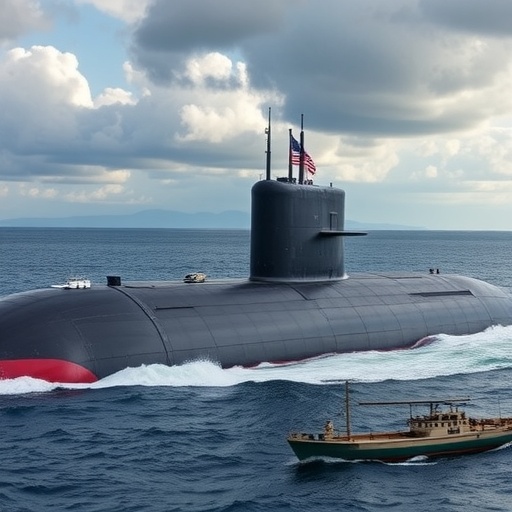Trump‘s Reassuring Update on AUKUS Submarine Deal
In a bold declaration that has reverberated through international defense circles, former President Donald Trump announced on Friday that the AUKUS submarine sales to Australia are firmly on track, undeterred by mounting global security challenges. Speaking at a high-profile event in Washington D.C., Trump emphasized the unbreakable commitment of the United States to its allies, stating, “The AUKUS pact is not just a deal; it’s a shield for freedom in the Indo-Pacific. We’re building those submarines, and nothing will stop us.” This statement comes at a time when geopolitical frictions, particularly with China, are intensifying, making the defense collaboration a cornerstone of regional stability.
The AUKUS security partnership, forged in 2021 between the United States, the United Kingdom, and Australia, aims to enhance military capabilities through advanced technologies, with nuclear-powered submarines at its heart. Trump’s intervention underscores his ongoing influence on U.S. foreign policy, even out of office, and signals continuity in defense priorities regardless of the current administration. As tensions simmer over Taiwan and the South China Sea, this assurance from Trump could bolster confidence among allies wary of delays in the multi-billion-dollar project.
Details of the announcement reveal that initial phases of technology transfer and design are progressing, with the first submarines expected to be operational by the early 2030s. According to sources familiar with the matter, U.S. shipyards are ramping up production of Virginia-class submarines, which form the backbone of the submarine sales to Australia. This development is not merely technical; it’s a strategic pivot that could reshape naval power dynamics in the Pacific.
Unpacking the AUKUS Framework and Its Submarine Core
The AUKUS agreement represents one of the most ambitious defense initiatives of the 21st century, born out of necessity amid China’s assertive expansion in the Indo-Pacific. Under the pact, Australia will acquire at least eight nuclear-powered submarines, a leap from its current fleet of diesel-electric vessels. This upgrade is estimated to cost upwards of $200 billion over the next three decades, with the U.S. and UK providing the nuclear propulsion technology while ensuring non-proliferation standards are met.
Trump, who has long championed strong military alliances, highlighted the pact’s roots during his presidency’s twilight. “We laid the groundwork for deals like this,” he remarked, crediting his administration’s focus on countering adversarial threats. The submarines in question are based on the U.S. Virginia-class, known for their stealth capabilities, advanced sonar systems, and ability to launch Tomahawk missiles. Each vessel can operate submerged for months, providing Australia with a formidable deterrent against potential aggressors.
From a technical standpoint, the submarine sales involve complex integrations. Australia‘s Osborne shipyards in South Australia will handle final assembly, creating thousands of jobs and stimulating the local economy. A recent report from the Australian Strategic Policy Institute notes that the project could generate over 20,000 direct and indirect jobs, underscoring its dual role in defense and economic growth. However, challenges persist: the cancellation of France’s conventional submarine contract in 2021 sparked diplomatic rows, and supply chain issues have occasionally slowed progress.
Experts point to the pact’s broader scope beyond submarines. AUKUS also encompasses hypersonic weapons, cyber capabilities, and quantum technologies, fostering a trilateral innovation hub. U.S. Secretary of Defense Lloyd Austin, in a parallel statement, echoed Trump’s optimism, saying, “Our partnership with Australia and the UK is ironclad, advancing shared security goals.” This synergy highlights how Trump‘s pronouncement aligns with official policy, bridging partisan divides on national security.
Australia’s Naval Ambitions Fueled by AUKUS Momentum
For Australia, the AUKUS submarine sales are transformative, elevating its role as a key player in Pacific defense. Prime Minister Anthony Albanese has repeatedly affirmed the government’s commitment, allocating $368 billion to the defense portfolio through 2031. In a recent address to parliament, Albanese stated, “These submarines will ensure Australia remains a sovereign power capable of defending our vast maritime borders.”
The strategic rationale is clear: Australia‘s 8,000-mile coastline and exclusive economic zone demand robust underwater assets. Currently operating Collins-class submarines built in the 1990s, the nation faces a capability gap as these vessels age. The new fleet, comprising SSN-AUKUS submarines designed collaboratively, will integrate seamlessly with U.S. and UK forces, enabling joint operations under exercises like Talisman Sabre.
Geopolitically, Australia views AUKUS as a bulwark against China’s growing naval presence. Beijing’s fleet, now the world’s largest with over 370 ships, includes advanced Type 093 submarines that patrol near Australian waters. A 2023 Lowy Institute poll revealed that 83% of Australians support the AUKUS deal, reflecting public buy-in despite environmental concerns over nuclear technology.
Implementation milestones include the 2023 signing of a trilateral pathway for submarine development. U.S. approvals for exporting sensitive tech have been expedited, with Congress passing the National Defense Authorization Act provisions to facilitate AUKUS. Trump‘s comments have invigorated these efforts, potentially accelerating funding and timelines. Australian defense officials report that workforce training programs are underway, partnering with U.S. naval bases in Guam and Hawaii.
- Key Benefits for Australia: Enhanced deterrence, interoperability with allies, and technological sovereignty.
- Challenges: High costs, skilled labor shortages, and diplomatic balancing with regional partners like Indonesia.
- Timeline: First U.S. Virginia-class subs to Australia by 2032; indigenous builds from 2040.
Geopolitical Ripples from Trump’s AUKUS Endorsement
Trump‘s endorsement arrives against a backdrop of heightened global security concerns, particularly in the Indo-Pacific theater. China’s military exercises around Taiwan and territorial claims in the Spratly Islands have prompted calls for stronger alliances. The AUKUS pact, in this context, serves as a counterweight, with submarine sales symbolizing U.S. resolve under Trump‘s enduring legacy.
International reactions vary. France, still smarting from the 2021 deal cancellation, has cautiously welcomed progress but demands transparency. In Asia, Japan and South Korea have expressed interest in similar pacts, viewing AUKUS as a model for Quad expansion. A RAND Corporation analysis estimates that AUKUS could deter aggression by increasing the perceived cost of conflict for adversaries by 30-40%.
Within the U.S., bipartisan support is evident. Republican Senator Jim Risch, a defense committee member, praised Trump‘s statement: “It’s a reminder that America leads when we commit to our friends like Australia.” Democrats, meanwhile, stress the pact’s role in multilateralism. Budgetary pressures loom, however; the U.S. Navy faces its own submarine shortfall, with only 49 attack subs against a target of 66.
Environmental and proliferation debates persist. Anti-nuclear groups in Australia argue the deal risks regional arms races, though proponents counter that the submarines use highly enriched uranium without weapons-grade material. The International Atomic Energy Agency has endorsed the non-proliferation safeguards, alleviating some fears.
Economically, the submarine sales ripple globally. UK firm BAE Systems is investing £4 billion in Australian facilities, while U.S. giants like General Dynamics Electric Boat see revenue boosts. A 2024 Deloitte study projects $100 billion in economic activity for Australia alone, fostering supply chains from titanium sourcing in Western Australia to AI integrations in California.
Charting the Path Forward for AUKUS and Global Defense
Looking ahead, Trump‘s declaration sets the stage for accelerated AUKUS implementation, with upcoming summits in Canberra and London poised to refine timelines. The U.S. plans to rotate Virginia-class submarines to Australian ports from 2027, building operational familiarity. This interim measure bridges the gap until full submarine sales materialize.
Broader implications extend to NATO and beyond. As defense spending rises—Australia‘s at 2.1% of GDP, the U.S. at 3.5%—AUKUS could inspire hybrid pacts incorporating AI-driven warfare. Challenges like workforce upskilling and tech export controls remain, but optimism prevails. Australian Defense Minister Richard Marles noted, “With partners like the U.S. and UK, we’re not just acquiring submarines; we’re securing a peaceful future.”
In the evolving landscape of great-power competition, Trump‘s words reinforce that AUKUS is more than a transaction—it’s a testament to enduring alliances. As production lines hum and alliances deepen, the Indo-Pacific watches closely, anticipating a more balanced security order.










